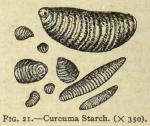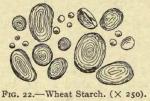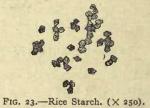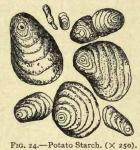The starch grains obtained from the fruit of Ze'a ma'ys Linné.
DESCRIPTION.—Usually in opaque, angular or columnar masses, easily pulverizable between the fingers, with a peculiar sound, into a fine white powder; odorless and tasteless. Under the microscope it is seen to be composed of small granules striated concentrically or excentrically around a nucleus or hilum. Insoluble in cold water, but with boiling water it forms a glutinous paste on cooling. Iodine is the test for starch, the characteristic blue color being produced when only a minute quantity of the latter is present.
Other starches—chiefly distinguished by the size and shape of the starch-granules as seen under the microscope:
 (a) AVENAE FARINAE.—Oatmeal. From Avena sativa Linné, probably native to Western Asia, but now a common field crop. A grayish-white, not uniform meal, containing the gluten and fragments of the integuments; bitterish. Demulcent and nutritive (due to the gluten contained).
(a) AVENAE FARINAE.—Oatmeal. From Avena sativa Linné, probably native to Western Asia, but now a common field crop. A grayish-white, not uniform meal, containing the gluten and fragments of the integuments; bitterish. Demulcent and nutritive (due to the gluten contained).
(b) SAGO.—Pearl Sago. Globular, pearl-like grains, white or brownish, prepared from Metroxylon sagu, M. rumphii, and other species growing in the East India Islands.
 ](c) TAPIOCA.—Cassava Starch. Yielded by the rhizomes of Brazilian plants, Manihot utilissima and M. aipi, nat. ord. Euphorbiaceae. White and opaque, irregular lumps.
](c) TAPIOCA.—Cassava Starch. Yielded by the rhizomes of Brazilian plants, Manihot utilissima and M. aipi, nat. ord. Euphorbiaceae. White and opaque, irregular lumps.
(d) TARO.—Taro Flour. A starch prepared from the corm of Colocasia esculenta Schott, the food (poi) of the natives in Hawaii and the West Indies. Recommended as a diet for dyspeptic and consumptive patients.
Starches from the underground parts of Triticum vulgare and Oryza sativa, Gramineae; Solanum tuberosum (potato starch), Solanaceae; Canna edulis, Maranta arundinacea, and Curcuma leucorrhiza, Scitamineae.

 Powder.—Microscopical elements of: See Part iv, Chap. I, B.
Powder.—Microscopical elements of: See Part iv, Chap. I, B.
CHEMICAL COMPOSITION.—Starch is the basis of that class of organic compounds termed carbohydrates. Its composition is C6H10O5. By hydrolysis it is converted into a gummy principle, dextrin, and glucose. Ferments convert it into alcohol and carbon dioxide—C6H10O5 = 2C2H5OH + 2CO2. Ash. Not more than 0.5 per cent.
ACTION AND USES.—Nutritive and demulcent.
- OFFICIAL PREPARATION.
- Glyceritum Amyli (10 per cent.).
- Dextrinum Album, N.F. (White dextrine should not yield more than 0.5 per cent. of ash.)







